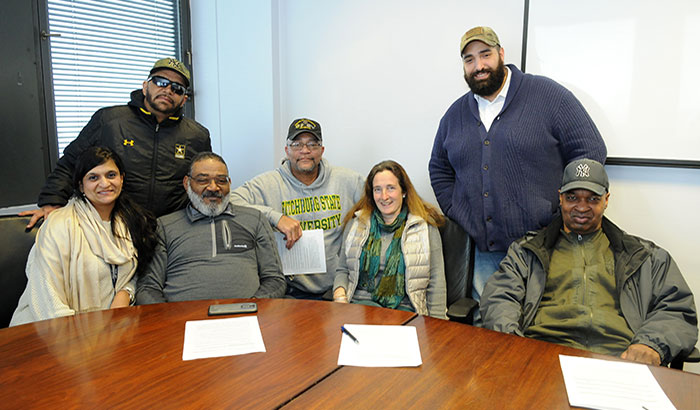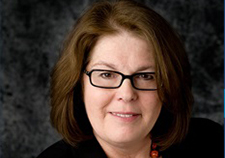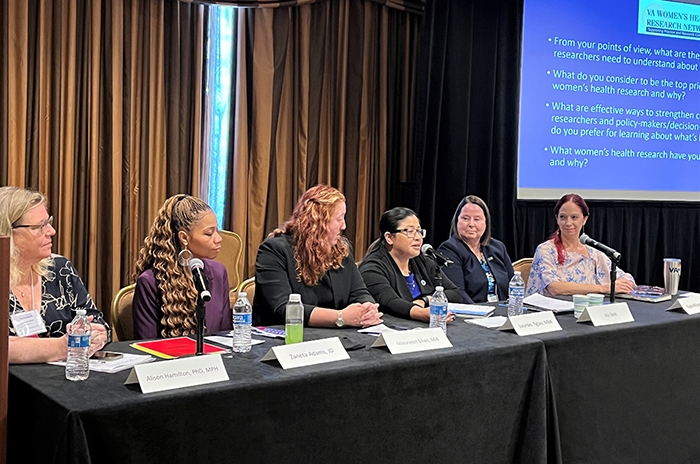Office of Research & Development |
 |


Jesse Brown (center) and Chris Murray (second from right) are part of a suicide-prevention group led by Drs. Marianne Goodman (third from right) and Kalpana Nidhi Kapil-Pair (left) at the Bronx VA Medical Center. (Photo by Yang Zhao)
March 28, 2018
By Mitch Mirkin
VA Research Communications
More MIRECC work on suicide prevention
Below is a brief rundown of other suicide-prevention research at the Mental Illness Research, Education, and Clinical Center at the Bronx VA. Read more
When Jesse Brown thinks back on his life, there’s a sharp dividing line around that grim day in September 2001 when terror struck the U.S.
“Before 9-11, I was happy. I was good.”
Brown, then with the New York Army National Guard’s 145th Maintenance Company out of Staten Island, took part in search and rescue at ground zero. He took in nightmarish scenes of victims in the rubble.
Then came his deployments to Iraq, three in all.
“Two of my guys getting killed. Hearing voices in your sleep. Going through the PTSD, the anger.”
Brown, now 58, received an honorable discharge in 2012, after 32 years of service, with deep wounds no one could see. The storm raging inside was more than he could bear. He eventually tried to take his own life.
"Veterans no longer feel alone. They feel someone understands their impulses and urges."
“I’ve been going through a lot of trials and tribulations. I was on a suicide ward.”
That’s when things began to turn around, just enough to give him some hope.
“They came and saved me. It’s been excellent.”
The “they” he refers to is Dr. Marianne Goodman and her team. Goodman is a psychiatrist and researcher who’s co-leading a suite of suicide-prevention projects at the James J. Peters VA Medical Center in the Bronx, New York. The work is part of the Mental Illness Research, Education, and Clinical Center at the site.
One study is Project Life Force. The idea is to bring together a cadre of Vets who all have a recent history of suicidal thinking and a completed suicide plan, provide them with group psychotherapy, and have them revise their safety plans as they incorporate the new skills they are learning.
While group sessions for those with issues like PTSD or anger are commonplace at VA hospitals, clinics, and Vet Centers, Goodman’s crew is doing relatively pioneering work by running a group for suicidal Veterans.
“This is new ground,” says Goodman, who is also with the Icahn School of Medicine at Mount Sinai. “This is the only manualized group therapy that specifically targets suicide. In the literature, there is a one-session inpatient safety planning group and an unstructured psychotherapy group, but otherwise, people have been reluctant to place suicidal individuals in a group together, for fear of contagion. Even DBT discourages discussion about active suicidal feelings.”
In other words, therapists have feared that allowing suicidal patients to mix with other suicidal patients and talk about their thoughts and feelings could actually increase risk. Goodman and her team are finding otherwise, at least with their Veterans cohort. She says the very power of the intervention appears to be the group.
“Veterans no longer feel alone,” says Goodman. “They feel someone understands their impulses and urges.”
The study was originally funded by VA’s Rehabilitation Research and Development Service, and now the Clinical Science R&D Service is supporting its expansion to a multisite trial. It uses elements from dialectical behavior therapy (DBT). This form of psychotherapy helps people cope with painful emotions and improve their relationships by teaching skills in mindfulness, distress tolerance, emotional regulation, and interpersonal effectiveness.
Goodman’s 10-session manualized version is slightly modified from classic DBT. It does not use the mindfulness component. It emphasizes friendship-building, and improving ties to family and the treatment team, as part of the interpersonal work. It adds education on gun safety, and minimizing access to other lethal means. And it shows the Vets how to use a mobile app to help them stick to their safety plan.

Dr. Jay Gorman
Suicide prevention care

VA Researcher Named One of U.S.’ Top Female Scientists

2023 VA Women's Health Research Conference

Self-harm is underrecognized in Gulf War Veterans
Jesse Brown started attending the group in 2016. He completed 12 sessions as a research participant but has continued attending, almost every week. He’s not out of the woods yet, but he’s making progress.
“If I’ve had a bad week, if something’s going on, instead of me trying to hurt myself, I go to the group and lay it out on the table. I let them know how I’m feeling. I get their feedback. I’ve got a great bunch of guys who are working with me. They help me, and I help them too.”
Brown says it’s important to him that the other men in the group are also Veterans.
“They are going through the same stuff I’m going through. You come back from the war, and you ask yourself, where do I fit in now?”
Goodman says it’s almost like the participants are back in the military, in terms of how they bond.
“The group cohesion, much to my surprise, has been an incredibly powerful factor in the intervention’s success. The Veterans recreate ‘units’ and come to group to make sure their ‘brothers and sisters stay alive.’ Just like in the military, their actions toward each other can save lives.”
The psychiatrist points out that many of the men and women in her groups lack family support—that can be part of the problem in the first place. In another clinical trial, called SAFER (Safe Actions for Families to Encourage Recovery), her team is involving families in suicide safety planning. Though it might seem surprising, families are typically not part of the process.
“Exactly how to communicate distress around suicidal feelings is very problematic for Veterans,” explains Goodman. “We were surprised to learn how difficult it is for Veterans to ask for help, and the fears about appearing vulnerable and ‘weak.’”
She adds: “Sometimes, family members are part of the stress leading to suicidal feelings. Learning to resolve these conflicts is important.”
Through SAFER, the researchers hope to learn more about how families can be part of the solution for Vets at risk for suicide.
“There is very little information on how family members can support their Veteran who is suicidal,” says Goodman. “Most of the information is on how to recognize suicide risk, but not how best to handle it.”
Chris Murray, 33, a participant in Project Life Force, is perhaps lucky on that point. It was his wife who reached out to the friends of the former Marine and National Guardsman when he tried to take his life in 2016. Those friends, mainly from Murray’s military days, would form a potent support network.
“After my suicide attempt, my wife had reached out to a bunch of my friends,” says Murray, who had two combat deployments to Iraq and two to Afghanistan. “A lot of them came from all around New York State to visit me in Westchester Presbyterian Hospital. Some of them came multiple times during the two weeks I was there. A lot of them came or called as often as they could.”
One of the things Murray says he has learned in Project Life Force is to carry his suicide safety plan with him at all times, along with a crisis line number. Another is to call on his friends when he needs them. He says he learned it is a powerful way to combat isolation.
“In the [Project Life Force] group, everyone admitted to some form of isolation. I picked up on that. And so one thing I started to do is, whenever I feel depressed, or am not feeling all there, I’ll reach out to one of my friends. And we’ll have a conversation for an hour or two, just about random things. And it will get me out of that funk. I’ll completely forget about why I was in that mood, and what I wanted to do. I’ll start to feel normal again.”
He says friends will also text him on a regular basis. “They’ll check in on me. They’ll text, Hey, how’s everything going? How you feeling? I’ve got a really good support network.”
But it’s also his buddies at the Bronx VA who keep him going strong. He made one friend in particular, a Vietnam Veteran, who he says helped him through tough times.
“He is closer to my Dad’s age. But some of the stuff he experienced in combat, I experienced. When I was talking about certain things, he could relate, and when he was talking about certain things, I could relate. He would talk about ways he would help himself, and I was like, I never tried that. I would try it and it would work for me. I thought, this is awesome. And I would tell him about certain things, and he would say, let me try that, and it would help him as well. To this day, when I see him at the VA, we’ll stop and get coffee and talk.”
Murray says that’s what he likes best about Project Life Force: having the support of other Veterans. “There are other Veterans there to help you, regardless of what you’ve been going through. They’ll be there for you, even though they’re going through stuff as well.”
Below is a brief rundown of other suicide-prevention research at the Mental Illness Research, Education, and Clinical Center at the Bronx VA.
Biomarkers for suicide risk— Lead investigator Dr. Vic Haghighi says her six-month study is looking at how “stress gets under the skin.” Through blood draws from 450 Veterans—350 with varying degrees of suicide risk, and 100 healthy in that regard—the team will look at levels of proteins and other substances in the blood, some linked to inflammation and stress, and see how they differ in suicidal Veterans. “Understanding the biological basis [of] the experience of combat stress is mission-critical toward the goal of zero Veteran suicides,” says Haghighi.
Brain imaging and emotion processing—Is there a faulty circuit in the brain of people who turn suicidal? Dr. Erin Hazlett’s team aims to find out through two types of MRI brain scans. “The theory is that decreased connectivity between the amygdala and frontal brain regions is associated with ‘affective instability,’” explains Hazlett. That means “people’s emotions are more easily triggered, are of higher sensitivity, and take longer to simmer back down. We are trying to see if affective instability and altered amygdala-frontal connectivity are related to suicide risk.”
Telehealth for at-risk Vets—Forty Veterans who were recently hospitalized for suicidal thinking are completing daily brief surveys via an interactive voice response system. The responses are sent to a central site at the Pittsburgh VA, where daily monitoring occurs. Any worrisome responses are then relayed to study clinicians, who reach out to the Veteran’s providers—and directly to the Veteran, if the concern is more urgent. Goodman, study lead at the Bronx VA, says the project “was initially designed to help augment treatment for those at highest risk and with hopes of facilitating improved connection with VA clinical staff.”
VA Research Currents archives || Sign up for VA Research updates